Recent Articles
Popular Makes
Body Types
2021 Kia Sorento Road Test and Review
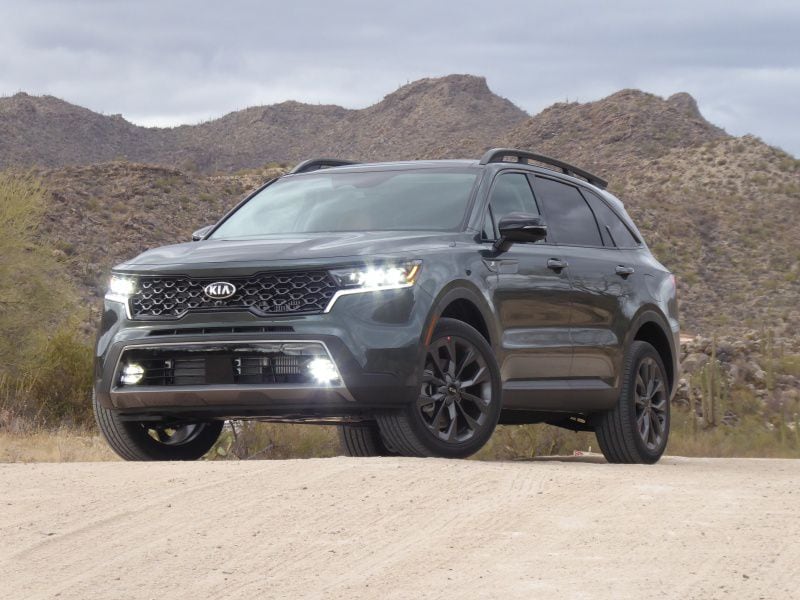
2021 Kia Sorento ・ Photo by Ron Sessions
The 2021 Kia Sorento is all-new from road to roof with a decidedly more-chiseled, square-jawed exterior design, a more inviting interior, a completely new gas-engine lineup, upgraded infotainment, and an expanded roster of safety and driver-assistive technology. It’s also available with a gas-electric hybrid powertrain which you can read about in a separate review. This three-row midsize SUV can seat six or seven passengers and is available with front- or all-wheel drive. The Sorento had been Kia’s best-selling SUV prior to the introduction of the smash-hit Telluride for 2020. It’s about 8 inches shorter overall than the also midsize Telluride.
The Sorento lineup grows to six trim levels this year: LX 2.5, S 2.5, EX 2.5T, SX 2.5T, SX Prestige 2.5T, and SX Prestige X-Line 2.5T. We tested the new off-road-oriented X-Line, which brings standard 20-inch alloy wheels, all-wheel drive, a snow mode, chunkier-looking roof rails, more aggressive-looking front and rear fascias, and an inch more ground clearance than other Sorentos. Including the $1,170 destination charge, prices start at $30,560 for the base front-drive LX trim and top out at $43,760 for the AWD-only X-Line. All-wheel drive is an $1,800 upcharge on most Sorento trims.
Engine and Transmission
The 2021 Sorento’s naturally aspirated base engine for the LX and S trims increases from 2.4 to 2.5 liters, adding 4 more horsepower and 3 more lb-ft of torque. Aiding flexibility is a new eight-speed automatic that replaces last year’s six-speed. EPA estimated fuel economy rises by 1 mpg overall to 26 mpg in combined driving with front-wheel drive and 24 mpg for AWD versions. This engine reaches 60 mph in a leisurely 9.5 seconds, which is Prius territory.
Much more engaging is the new turbocharged 281-hp 2.5-liter four-cylinder in EX and SX trims, replacing last year’s 3.3-liter V6. With 311 lb-ft of torque on tap from just 1,700 rpm all the way to 4,000 rpm, this engine is more responsive than the previous V6 in everyday driving. Throttle response is crisp and rewarding. The turbo-four sounds good, too, with a melodious eagerness. Key to the turbo engine’s appeal is its all-new eight-speed dual-clutch transmission that delivers quicker, more seamless shifts. Unlike earlier dual-clutch transmissions that can be lurchy accelerating from a stop, this new DCT is a wet-plate type that offers smoother launches. Sprints to 60 mph take just over 7.0 seconds. The performance gain is accompanied by a sizable improvement of 3 to 4 mpg over the previous V6 in combined driving.
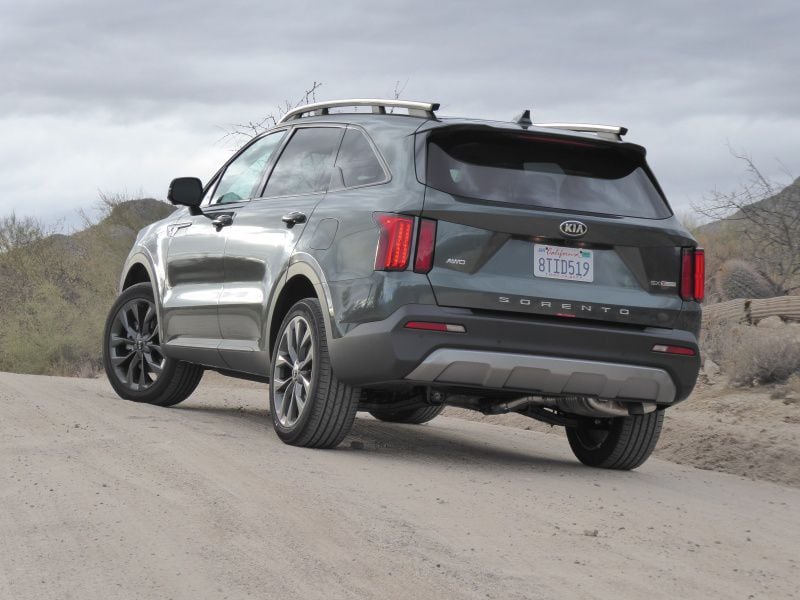
Photo by Ron Sessions
Controls and Comfort
The new Sorento’s slightly larger interior has a functional, durable-goods look. Attractive double-stitching enhances the seats, door armrests, and center console lid. A total of eight prominent adjustable air vents populate the instrument panel for front-seat comfort. Storage is ample with a large dash glovebox, pockets in the doors, a handy shelf atop the passenger’s side of the dash and a large console with dual cup holders, covered storage under the center armrest, a bin for coins, keyfobs, and such, plus a tray forward of the console shifter with power ports for electronic devices.
Ahead of the driver on all but SX Prestige models are traditional analog gauges flanking a smallish, 4.2-inch color TFT/LCD cluster for fuel economy and other driver information. SX Prestige models upgrade to a reconfigurable 12.3-inch meter cluster. All but the base LX 2.5 gets a power driver seat, while the SX 2.5T and SX 2.5T Prestige add a power front passenger seat. Seat coverings are cloth in the base LX 2.5, faux leather in S 2.5, EX 2.5T, and SX 2.5T, and perforated quilted-pattern leather with SX 2.5T Prestige trims. The front chairs are heated on all but the base LX 2.5 and ventilated on SX Prestige trims. Brightening the outlook of passengers in the SX and SX Prestige trims is a panoramic sunroof.
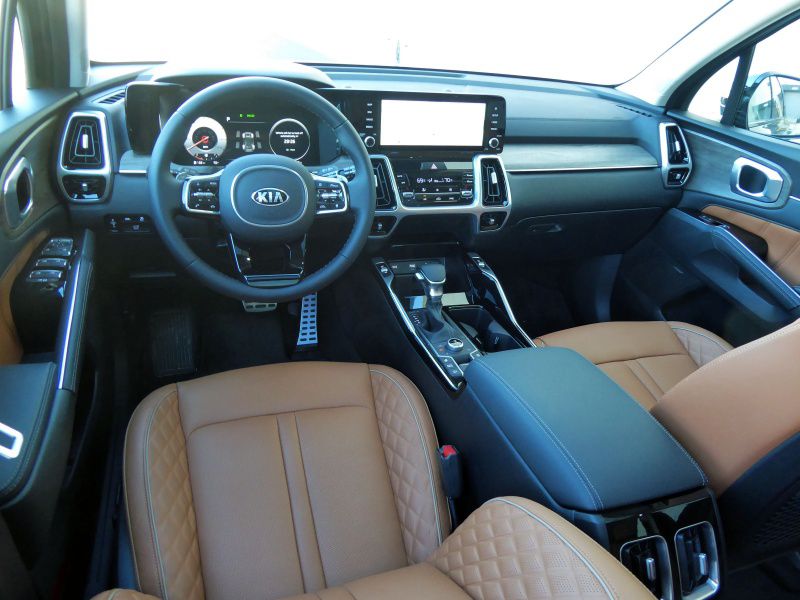
Photo by Ron Sessions
Infotainment
Standard in the LX 2.5, S 2.5 and EX 2.5T is an 8-inch color touchscreen with Bluetooth voice recognition, wireless Apple CarPlay and wireless Android Auto cellphone mirroring. Audio is provided by a 6-speaker AM/FM stereo in the LX 2.5 and adds SiriusXM satellite radio for S 2.5 and EX 2.5T models.
Moving up to SX 2.5T or SX Prestige trim upgrades the infotainment screen to a 10.25-inch display with imbedded navigation and wired, instead of wireless, Apple CarPlay and Android Auto cellphone mirroring that require a USB cable to function. The top audio offering, standard in SX Prestige trims, is a 12-speaker Bose surround sound system with crystal-clear fidelity that literally immerses cabin occupants in a sound stage.
SX and higher trims also include UVO link telematics with advanced connected vehicle features.
There are USB ports on all three rows. A wireless device charger is standard in all turbocharged models. No Wi-Fi hot spot is available, however.
One of the neater features of the larger 10.25-inch display are the Sounds of Nature. Accessed via the Media button, the user can chill out to the comforting sounds of a crackling fireplace, birds in a rain forest, rhythmic waves pulsing on a sandy beach and more.
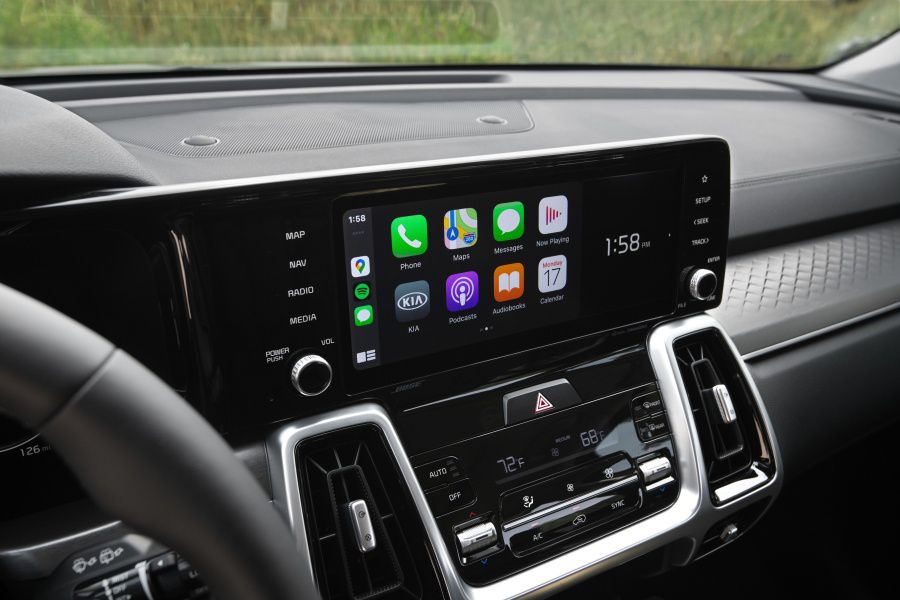
Photo by Kia
Drive Modes
Mounted on the center console is the drive mode select knob. Comfort, Sport, Smart, and Eco modes are standard in all models, while the SX Prestige X-Line adds a standard Snow mode (optional with other trims). The mode settings vary throttle response, transmission shifting, and traction control settings for the purpose at hand. Keeping in mind that the Sorento is more of a mainstream crossover suv destined for duty on pavement and the occasional dirt-road sortie to Grandma’s house for Thanksgiving dinner, there are no dedicated off-road modes as found in Jeeps, Land Rovers, and Ford Broncos.
Nestled between the drive modes of Sorentos equipped with all-wheel drive is a button for the locking center differential. Pushing the button directs half of the engine’s drive torque to the front wheels and half to the rears and maintains that ratio until the button is pushed again, reverting the AWD system to on-demand operation. In normal operation, the Sorento’s on-demand AWD operates as a front-drive system unless it detects reduced traction whereupon it can send up to 50 percent of drive torque to the rear wheels as well. It also uses torque-vectoring technology that improves steering response.
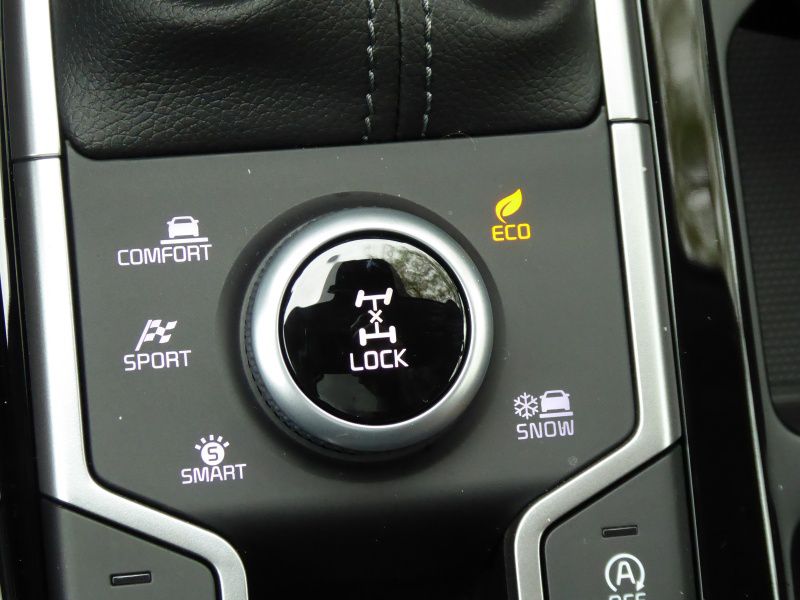
Photo by Ron Sessions
Second Row
The difference between six- and seven-passenger Sorentos is the middle-row seating — either a 60/40 split-folding three-passenger bench or, on 2.5T models, a pair of captain’s chairs. The middle-row slides fore and aft, both to allow access to the third-row seats and to apportion legroom between passengers in the two rows.
If no one is sitting in the third row, sliding the middle-row seat/s all the way back provides up to 41.7 inches of middle-row legroom, generous for the segment. For third-row access, a single easy-to-use lever lowers the middle-row seatback and slides the seat bottom forward against the front seatback. With either middle-row seat setup, there’s more-than-adequate headroom and legroom for full-grown adults. The seatbacks can be individually reclined for comfort. Rear seat entertainment is a $1,500 option.
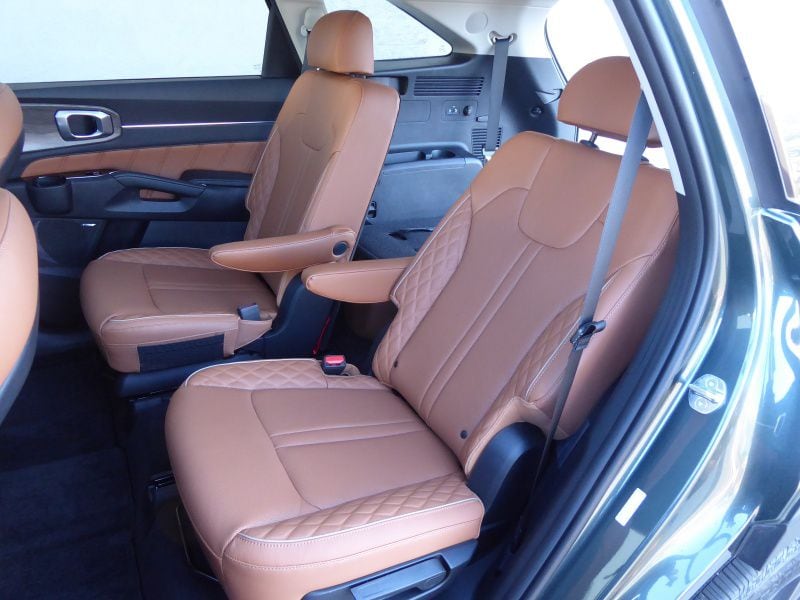
Photo by Ron Sessions
Third Row
Many mid-size crossovers such as the Chevrolet Blazer, Ford Edge, Nissan Murano, and Subaru Outback — and even Kia’s corporate stablemate, the Hyundai Santa Fe — offer seating only for five passengers. Instead, the Sorento comes with three rows of seats and six- or seven-passenger capacity that carries one notable footnote.
In order to package a third-row seat in the Sorento, which is nearly 8 inches shorter than the Kia Telluride, the aft chairs are really only suitable for children and small teens. Headroom is OK for adults, but legroom is in short supply and the low-mounted seat cushions mean passengers will be sitting with their knees up in the air. The seat is split 50/50 so owners can fold down one side for added cargo space while keeping the other side open for someone who wants to crawl back there. Third-row seating is standard with all Sorento trims.
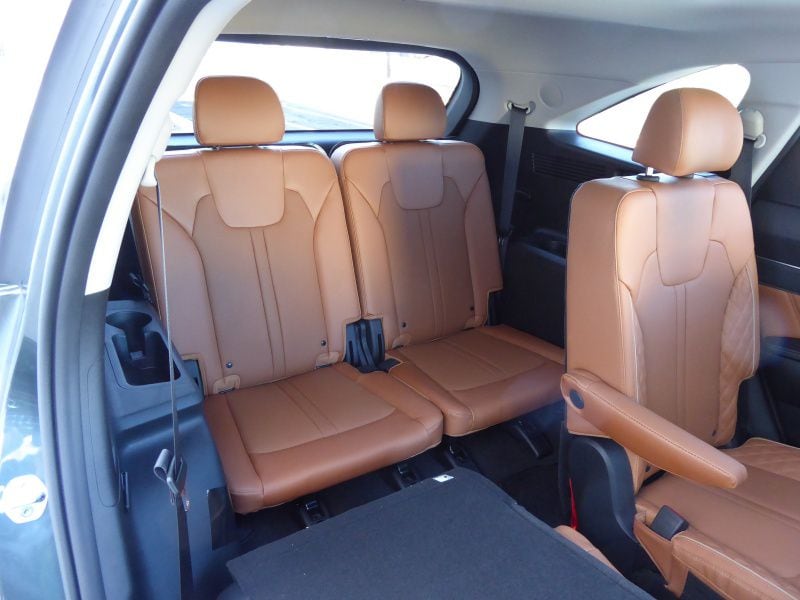
Photo by Ron Sessions
Max Cargo
Cargo space is a scant 12.6 cubic feet behind the Sorento’s raised third-row seat, enough for a pair of standard-size airline roller bags. That’s about 40 percent less room than that offered in the larger Kia Telluride with its third-row seat in the raised position.
Most owners will want to keep the Sorento’s third row folded except when needed to ferry small folk, netting anywhere between 38.5 and 45 cubic feet of space behind the sliding second-row seats. In maximum space mode, with the second-row seatbacks lowered, the 2021 Sorento offers a yawning 75.5 cubic foot cargo space. The liftgate is power-operated on all turbocharged 2.5-liter models. The Sorento’s cargo floor height can be set in one of two positions. A small amount of hidden storage for small items like a camera, tablet, or purse is available under the cargo floor.
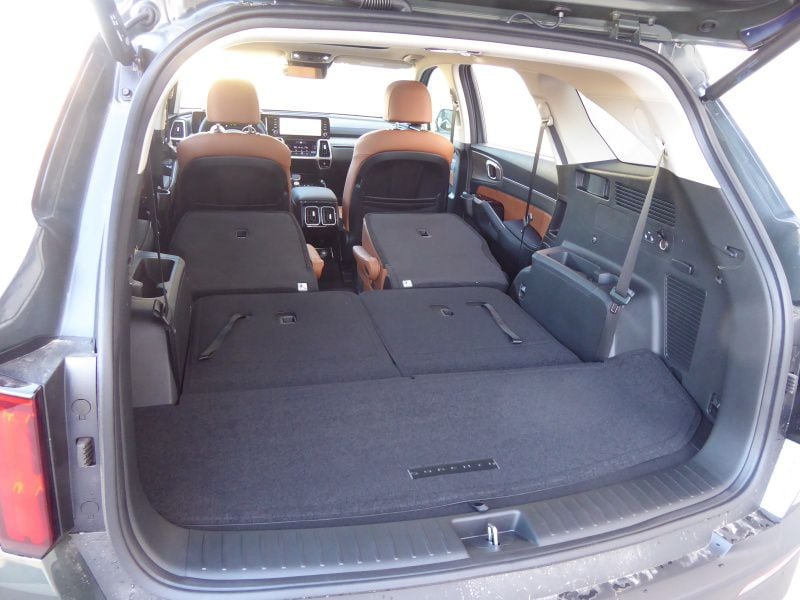
Photo by Ron Sessions
Sorento Dynamics — On- and Off-Road
Riding on a new platform, the 2021 Sorento’s stiffer structure pays benefits in terms of more direct responses to driver inputs and reduced noise, vibration, and harshness. Our test vehicle was the AWD SX Prestige X-Line riding on 20-inch all-season tires. Lower trims come with 17- or 18-inch rubber. Typically, larger-diameter wheels are harsher riding due to less air cushion between the road and the wheel, but the X-Line’s ride, while firm, didn’t suffer notable harshness on impacts.
On the highway, steering weighting and precision were spot-on and the 2021 model’s quicker ratio gave the SUV a pleasing responsiveness. Firm, top-of-pedal brake feel was appreciated as well. On a primitive dirt road, the X-Line’s added ground clearance, while about a half-inch less than that of the Subaru Outback’s, helped keep the Sorento from scraping and bottoming out over deep ruts and soccer-ball-size rocks. Maximum towing capacity with the base 2.5 engine is 2,000 lbs, improving to 3,500 lbs with the turbo 2.5.
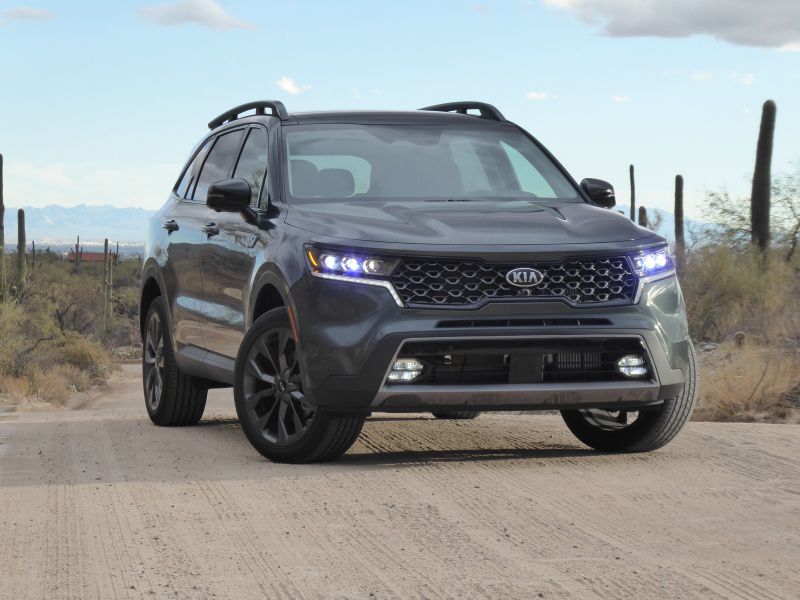
Photo by Ron Sessions
Safety and Driver-Assistive Tech
In addition to seven airbags and a backup camera, all trims come standard with rear occupant alert, forward collision avoidance with automatic emergency braking for cars and pedestrians, a driver attention warning, lane-keeping and lane-following assist, a lane-departure warning, intelligent speed-limit assist, and automatic high beams.
All but the base LX 2.5 trim bring standard blind-spot and rear cross-traffic warnings, rear parking sensors, and safe exit assist. Turbocharged 2.5T trims add standard smart cruise control with stop and go, as well as forward collision avoidance assist for cyclists and at traffic junctions. The SX 2.5T and SX Prestige 2.5T add highway driving assist (smart cruise control with lane-centering). The SX Prestige 2.5T brings a 360-degree surround-view monitor to replace the basic backup camera, adds a blind-view camera that displays a rear-quarter view down the side of the SUV in the dash when the turn signal is actuated, includes forward parking sensors, and provides and rear parking collision avoidance that automatically applies the brakes. None of the safety or driver-assistive systems is available optionally, so if those technologies are important to you, stick with one of the higher trim levels.
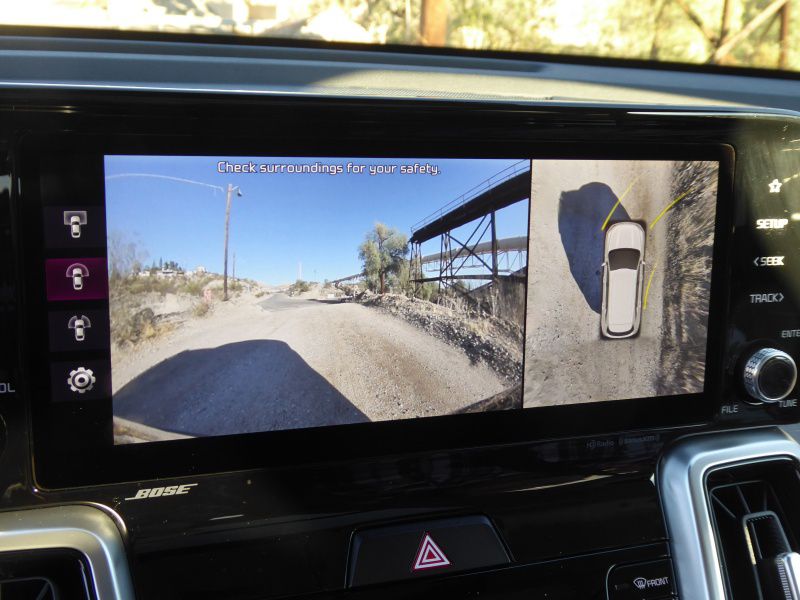
Photo by Ron Sessions
Bang for the Buck
The Kia Sorento is a content-packed, attractively styled mid-size sport-utility that offers a lot of value for the dollar. It combines the overall size and garageability of a two-row mid-size SUV with the convenience of an occasional-use third-row seat. All-new for 2021 with livelier and more fuel-efficient powertrains, significantly upgraded infotainment and telematics, as well as a greatly expanded roster of safety and driver-assistive technology, the Sorento offers a compelling sales proposition among mid-size SUVs.
Elsewhere on this site, you can read about the first-ever Kia Sorento Hybrid. Later in the 2021 model, Kia will introduce a plug-in hybrid version as well.
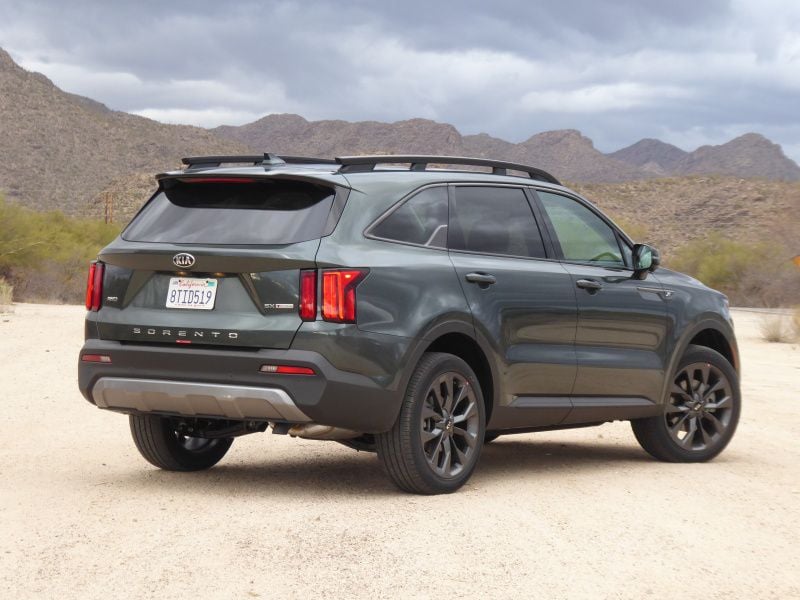
Photo by Ron Sessions